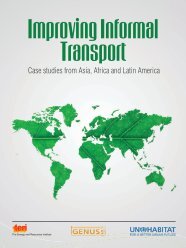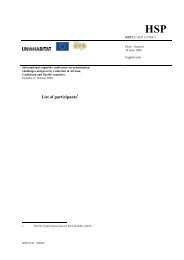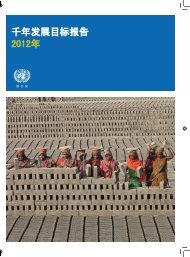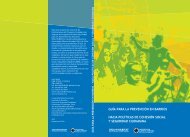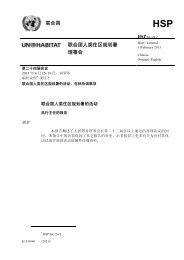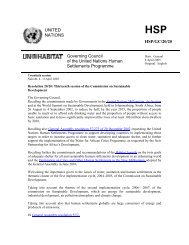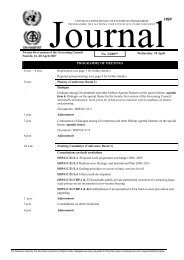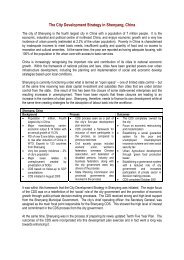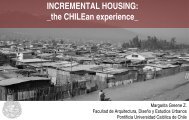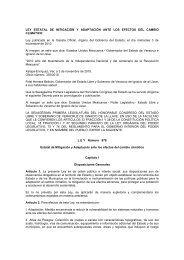Theoretical and empirical researches in urban ... - UN-Habitat
Theoretical and empirical researches in urban ... - UN-Habitat
Theoretical and empirical researches in urban ... - UN-Habitat
Create successful ePaper yourself
Turn your PDF publications into a flip-book with our unique Google optimized e-Paper software.
<strong>Theoretical</strong> <strong>and</strong> Empirical Researches <strong>in</strong> Urban Management<br />
Number 5 (14) / February 2010<br />
Research Center <strong>in</strong> Public Adm<strong>in</strong>istration <strong>and</strong> Public Services<br />
Academy of Economic Studies, Bucharest, Romania<br />
THEORETICAL AND EMPIRICAL<br />
RESEARCHES<br />
IN<br />
URBAN MANAGEMENT<br />
Number 5 (14)<br />
February 2010<br />
Quarterly<br />
ISSN: 2065-3913<br />
ISSN: 2065- 3913
Research Center <strong>in</strong> Public Adm<strong>in</strong>istration <strong>and</strong> Public Services<br />
Academy of Economic Studies, Bucharest, Romania<br />
THEORETICAL AND EMPIRICAL<br />
RESEARCHES<br />
IN<br />
URBAN MANAGEMENT<br />
Number 5 (14)<br />
February 2010<br />
Indexed or abstracted <strong>in</strong>:<br />
Gale Cengage (Academic Onefile)<br />
ProQuest Science Journals<br />
Directory of Open Access Journals<br />
Index Copernicus<br />
Ulrich Directory<br />
Scirus<br />
REPEC (EconPapers, Ideas, Socionet)<br />
Scientific Commons<br />
Genamics<br />
Google Scholar<br />
International Consortium for the Advancement of Academic Publications<br />
Intute<br />
Elektronische Zeitschriftenbibliothek<br />
Knowledge Base Social Sciences Eastern Europe<br />
ISSN: 2065 - 3913
Publisher<br />
Research Center <strong>in</strong> Public Adm<strong>in</strong>istration <strong>and</strong> Public Services<br />
Academy of Economic Studies, Bucharest, Romania<br />
Calea Şerban Vodă 22-24, Bucureşti, sector 4, Romania, 040211<br />
Editorial team<br />
Colesca Sofia Elena<br />
Stefan Ionela Georgiana<br />
Burcea Stefan<br />
Advisory Committee<br />
Afolabi Aribigbola, Adekunle Ajas<strong>in</strong> University, Nigeria<br />
Ahmed Soliman, Alex<strong>and</strong>ria University, Alex<strong>and</strong>ria, Egypt<br />
Camelia Ratiu-Suciu, Academy of Economic Studies, Bucharest, Romania<br />
Cosm<strong>in</strong> Dobr<strong>in</strong>, Academy of Economic Studies, Bucharest, Romania<br />
Cristian Banacu, Academy of Economic Studies, Bucharest, Romania<br />
Crist<strong>in</strong>a Alpopi, Academy of Economic Studies, Bucharest, Romania<br />
Crist<strong>in</strong>a Iacoboaea, Technical University of Civil Eng<strong>in</strong>eer<strong>in</strong>g, Bucharest, Romania<br />
Daniela Grigori, Versailles Sa<strong>in</strong>t-Quent<strong>in</strong>-en-Yvel<strong>in</strong>es University, France<br />
Daniela Hîncu, Academy of Economic Studies, Bucharest, Romania<br />
Dragoş Frăs<strong>in</strong>eanu, Spiru Haret University, Bucharest, Romania<br />
Florian Petrescu, Technical University of Civil Eng<strong>in</strong>eer<strong>in</strong>g, Bucharest, Romania<br />
Florica Luban, Academy of Economic Studies, Bucharest, Romania<br />
Gheorghe Cârstea, Academy of Economic Studies, Bucharest, Romania<br />
Giancarlo Bova, Piazzola Academy, Roma, Italy<br />
Hongyi Bi, Sh<strong>and</strong>ong Economic University, J<strong>in</strong>an, Ch<strong>in</strong>a<br />
Ion Popa, Academy of Economic Studies, Bucharest, Romania<br />
Ismail Omar, Univesiti Teknologi Malaysia, Malaysia<br />
Javier Ruiz Mart<strong>in</strong>ez, Carlos III University, Madrid, Spa<strong>in</strong><br />
Krist<strong>in</strong>a Zgodavova, Alex<strong>and</strong>er Dubcek University <strong>in</strong> Trenc<strong>in</strong>, Slovakia<br />
Liliana Dobrica, Politehnica University of Bucharest, Romania<br />
Lucia Melnic, Ovidius University, Constanţa, Romania<br />
Marija Maks<strong>in</strong>-Micic, University S<strong>in</strong>gidunum, Belgrade, Serbia<br />
Maro Vlachopoulou, University of Macedonia, Thessaloniki, Greece<br />
Nadia Ciocoiu, Academy of Economic Studies, Bucharest, Romania<br />
Oana Luca, Technical University of Civil Eng<strong>in</strong>eer<strong>in</strong>g, Bucharest, Romania<br />
Prabhat Kumar Datta, Calcuta University, India<br />
Sofia Elena Colesca, Academy of Economic Studies, Bucharest, Romania<br />
Spyros Kitsiou, University of Macedonia, Thessaloniki, Greece<br />
Surya Narayan Misra, Utkal University, Orissa, India<br />
Valent<strong>in</strong> Teodorescu, Spiru Haret University, Bucharest, Romania<br />
Vasile Glăvan, Spiru Haret University, Bucharest, Romania<br />
Copyright © TERUM<br />
The articles published <strong>in</strong> the journal are protected by copyright. Any reproduction, modification,<br />
publication, transmission, transfer, or exploitation of any of the Content, whether <strong>in</strong> whole or <strong>in</strong> part,<br />
without express written permission is prohibited.<br />
ISSN: 2065- 3913
TABLE OF CONTENTS<br />
NUMBER 5 (14)<br />
FEBRUARY 2010<br />
1. CITIES COMPETITION, PLACE MARKETING AND ECONOMIC DEVELOPMENT IN SOUTH<br />
EUROPE: THE BARCELONA CASE AS FDI DESTINATION<br />
Theodore METAXAS<br />
5-19<br />
2. PATHWAYS TOWARDS URBAN FORMALIZATION IN EGYPTIAN CITIES<br />
Ahmed SOLIMAN<br />
20-46<br />
3. VULNERABILITY OF URBAN INFORMAL SECTOR: STREET VENDORS IN YOGYAKARTA,<br />
INDONESIA<br />
Aloysius Gunadi BRATA<br />
47-58<br />
4. METROPOLITAN GOVERNMENT AND IMPROVEMENT POTENTIALS OF URBAN BASIC<br />
SERVICES GOVERNANCE IN DHAKA CITY, BANGLADESH: RHETORIC OR REALITY?<br />
Golam MOINUDDIN<br />
5. RAPID URBAN SECTOR PROFILING FOR SUSTAINABILITY STUDIES (RUSPS) IN<br />
DEVELOPING CO<strong>UN</strong>TRIES: IMPLICATIONS FOR URBAN PLANNING IN ONDO STATE,<br />
NIGERIA<br />
Johnson Bade FALADE<br />
Afolabi ARIBIGBOLA<br />
6. FISCAL MANAGEMENT IN DANGILA M<strong>UN</strong>ICIPALITY, ETHIOPIA. PERFORMANCE AND POLICY<br />
IMPLICATIONS<br />
Edson MBEDZI<br />
Tendayi GONDO<br />
7. URBAN DEVELOPMENT IN ZIMBABWE: A HUMAN SETTLEMENT PERSPECTIVE<br />
Killian M<strong>UN</strong>ZWA<br />
Jonga WELLINGTON<br />
59-81<br />
82-94<br />
95-119<br />
120-146<br />
8. COMPUTER AIDED DESIGN IN URBAN ARHITECTURE 3D MODELING<br />
Nicolae Radu MÂRŞANU<br />
Silvia Mihaela RUSU<br />
147-164<br />
9. THE ROLE OF URBAN MARKETING IN LOCAL ECONOMIC DEVELOPMENT A POLITICAL<br />
ECONOMIC PERSPECTIVE<br />
Frankl<strong>in</strong> OBENG-ODOOM<br />
165-171
nt<br />
<strong>Theoretical</strong> <strong>and</strong> Empirical Researches <strong>in</strong> Urban Management<br />
Number 5(14) / February 2010<br />
Falade J.B. <strong>and</strong> Aribigbola A.<br />
RAPID URBAN SECTOR PROFILING FOR SUSTAINABILITY STUDIES (RUSPS) IN DEVELOPING CO<strong>UN</strong>TRIES.<br />
IMPLICATIONS FOR URBAN PLANNING IN ONDO STATE, NIGERIA<br />
RAPID URBAN SECTOR PROFILING FOR<br />
SUSTAINABILITY STUDIES (RUSPS) IN<br />
DEVELOPING CO<strong>UN</strong>TRIES: IMPLICATIONS<br />
FOR URBAN PLANNING IN ONDO STATE,<br />
NIGERIA<br />
Johnson Bade FALADE<br />
<strong>UN</strong>-HABITAT<br />
United Nations House, Plot 617/61, Central Area District, Abuja, Nigeria<br />
jb_falade@hotmail.com<br />
Afolabi ARIBIGBOLA<br />
Department of Geography <strong>and</strong> Plann<strong>in</strong>g Sciences, Adekunle Ajas<strong>in</strong> University<br />
Akungba Akoko, Ondo State, Nigeria<br />
faribs1@yahoo.com<br />
ABSTRACT<br />
This paper explores the application of rapid <strong>urban</strong> profil<strong>in</strong>g for susta<strong>in</strong>ability studies (RUSPS) <strong>in</strong> articulat<strong>in</strong>g city<br />
strategic plans <strong>in</strong> develop<strong>in</strong>g countries with the aim of determ<strong>in</strong><strong>in</strong>g its implications for <strong>urban</strong> plann<strong>in</strong>g <strong>in</strong> Ondo<br />
State, Nigeria. Ondo State is one of the 36 states of Nigeria where <strong>urban</strong> plann<strong>in</strong>g is undertaken by the state<br />
government. It discusses the usefulness of the methodology to <strong>urban</strong> plann<strong>in</strong>g <strong>and</strong> suggests how it can be applied<br />
to re-<strong>in</strong>vigorate <strong>urban</strong> plann<strong>in</strong>g activity <strong>in</strong> the state. The paper draws on document analysis, qualitative research as<br />
well as systematic survey of plann<strong>in</strong>g activities, departments <strong>and</strong> agencies of government as well as <strong>in</strong>dividuals<br />
<strong>in</strong>volved <strong>in</strong> <strong>urban</strong> plann<strong>in</strong>g tasks <strong>in</strong> the study area. Other relevant materials <strong>and</strong> data are sourced from published<br />
sources. The paper reveals that RUSPS has a lot of implications for <strong>urban</strong> plann<strong>in</strong>g <strong>in</strong> Ondo state, where it is at<br />
present wholly concerned with the approval of plans such as build<strong>in</strong>g <strong>and</strong> layout plans without overall city<br />
development strategies. The paper concludes that for plann<strong>in</strong>g to flourish <strong>and</strong> more importantly stem the grow<strong>in</strong>g<br />
slum formation <strong>and</strong> poverty <strong>in</strong> the study area, there is a need for a more fundamental reth<strong>in</strong>k<strong>in</strong>g of city plann<strong>in</strong>g<br />
<strong>and</strong> development approaches <strong>and</strong> actions to be <strong>in</strong>clusive, participatory <strong>and</strong> one to be undertaken at the local level.<br />
RUSPS offers this.<br />
Key words: Urban Sector Profil<strong>in</strong>g, Susta<strong>in</strong>ability studies, <strong>urban</strong> plann<strong>in</strong>g, Develop<strong>in</strong>g countries, Master plans,<br />
City strategic Plans, Structure plan, <strong>urban</strong> assessment, <strong>urban</strong> governance <strong>and</strong> management.<br />
1. INTRODUCTION<br />
The cities <strong>in</strong> develop<strong>in</strong>g countries have been witness<strong>in</strong>g rapid <strong>and</strong> spontaneous growth <strong>in</strong> recent times<br />
result<strong>in</strong>g <strong>in</strong> a myriad of problems. The menace of <strong>urban</strong> sprawl <strong>and</strong> deteriorat<strong>in</strong>g environment, hous<strong>in</strong>g<br />
shortages, unemployment <strong>and</strong> other socio-economic <strong>and</strong> environmental problems prevalent <strong>in</strong> most<br />
82
nt<br />
<strong>Theoretical</strong> <strong>and</strong> Empirical Researches <strong>in</strong> Urban Management<br />
Number 5(14) / February 2010<br />
Falade J.B. <strong>and</strong> Aribigbola A.<br />
RAPID URBAN SECTOR PROFILING FOR SUSTAINABILITY STUDIES (RUSPS) IN DEVELOPING CO<strong>UN</strong>TRIES:<br />
IMPLICATIONS FOR URBAN PLANNING IN ONDO STATE, NIGERIA<br />
develop<strong>in</strong>g countries has made new th<strong>in</strong>k<strong>in</strong>g <strong>and</strong> approaches to solv<strong>in</strong>g them <strong>in</strong>dispensable if the<br />
security <strong>and</strong> welfare of city dwellers are to be guaranteed. The <strong>urban</strong> crisis <strong>in</strong> develop<strong>in</strong>g countries has<br />
attracted the attention of scholars, decision makers, donors <strong>and</strong> multilateral agencies globally <strong>and</strong><br />
consequently the design of policies <strong>and</strong> programmes to combat it. Therefore, as part of <strong>UN</strong>-HABITAT<br />
drive to address cities' crisis associated rapid <strong>urban</strong>ization <strong>in</strong> conjunction with the European<br />
Commission (EC) <strong>and</strong> other partners to support susta<strong>in</strong>able city development <strong>and</strong> also be able to<br />
address their urgent <strong>and</strong> diverse needs, found it necessary to develop a tool for rapid <strong>urban</strong> assessment<br />
to guide immediate <strong>and</strong> mid- <strong>and</strong> long-term <strong>in</strong>terventions. L<strong>and</strong> use plann<strong>in</strong>g has witnessed notable<br />
changes <strong>in</strong> concept, scope, methodology <strong>and</strong> content <strong>in</strong> the last four decades. The process of l<strong>and</strong> use<br />
plann<strong>in</strong>g had become more <strong>in</strong>clusive <strong>and</strong> participatory <strong>and</strong> engag<strong>in</strong>g city dwellers to provide relevant<br />
<strong>in</strong>formation, identify <strong>and</strong> prioritize development opportunities, which must form the basis for formulat<strong>in</strong>g<br />
a flexible city development strategy/ structure plan as opposed to the old rigid „master plan‟ (Falade,<br />
2009). The latest methodology or approach be<strong>in</strong>g utilized follow<strong>in</strong>g the leadership of <strong>UN</strong>- <strong>Habitat</strong> is<br />
known as Rapid Sector Profil<strong>in</strong>g for Susta<strong>in</strong>ability studies (RUSPS) first developed by the <strong>UN</strong> –<br />
HABITAT work<strong>in</strong>g with the European Commission on <strong>urban</strong> sector profile study <strong>in</strong> Somalia <strong>in</strong> 2003.<br />
The Rapid Urban Sector Profil<strong>in</strong>g is the first phase of the Participatory Slum Upgrad<strong>in</strong>g Programme<br />
(PSUP) <strong>and</strong> it is designed to support the achievement of Target 11 of the Millennium Development<br />
Goals by sett<strong>in</strong>g up slum improvement action plans <strong>in</strong> selected countries <strong>and</strong> towns. It applies <strong>in</strong>clusive<br />
<strong>urban</strong> governance <strong>and</strong> management us<strong>in</strong>g participatory methods to implement slum upgrad<strong>in</strong>g<br />
activities. Target beneficiaries of the programme <strong>in</strong>clude the <strong>urban</strong> poor, women-headed households<br />
<strong>and</strong> marg<strong>in</strong>alized groups (<strong>UN</strong>-HABITAT, 2008). The Urban Sector profil<strong>in</strong>g exercise has been<br />
extensively researched, piloted <strong>and</strong> developed with the goal of enabl<strong>in</strong>g improved <strong>and</strong> more effective<br />
<strong>urban</strong> management <strong>and</strong> implementation at the national <strong>and</strong> local levels. The first phase of the Urban<br />
Sector Profil<strong>in</strong>g was successfully implemented <strong>in</strong> over 20 countries <strong>and</strong> has contributed to public policy<br />
to the extent that countries such as Egypt, the K<strong>in</strong>gdom of Bahra<strong>in</strong> <strong>and</strong> Nigeria have opted to f<strong>in</strong>ance<br />
the programme themselves. All <strong>in</strong> all, around 40 countries are now partner<strong>in</strong>g to <strong>in</strong>corporate this study<br />
<strong>and</strong> process <strong>in</strong>to their current <strong>urban</strong> management structures to better identify <strong>and</strong> agree on <strong>urban</strong><br />
development capacity build<strong>in</strong>g <strong>and</strong> <strong>in</strong>vestment priorities (<strong>UN</strong>-HABITAT, 2008)<br />
It is aga<strong>in</strong>st the above scenarios, that this paper seeks to exam<strong>in</strong>e RUSPS approach to improv<strong>in</strong>g city<br />
plann<strong>in</strong>g <strong>and</strong> management structure <strong>in</strong> contemporary develop<strong>in</strong>g countries. The overrid<strong>in</strong>g aim is to<br />
outl<strong>in</strong>e its implications for <strong>urban</strong> plann<strong>in</strong>g <strong>in</strong> Ondo state, Nigeria. In do<strong>in</strong>g this, the paper identifies <strong>and</strong><br />
discusses the major components of the methodology, its relevance as well as its application generally to<br />
the articulation of structure plans aimed at provid<strong>in</strong>g city development strategies to meet MDGs targets<br />
83
nt<br />
<strong>Theoretical</strong> <strong>and</strong> Empirical Researches <strong>in</strong> Urban Management<br />
Number 5(14) / February 2010<br />
Falade J.B. <strong>and</strong> Aribigbola A.<br />
RAPID URBAN SECTOR PROFILING FOR SUSTAINABILITY STUDIES (RUSPS) IN DEVELOPING CO<strong>UN</strong>TRIES.<br />
IMPLICATIONS FOR URBAN PLANNING IN ONDO STATE, NIGERIA<br />
<strong>in</strong> develop<strong>in</strong>g countries especially <strong>in</strong> Africa that has been identified as lagg<strong>in</strong>g beh<strong>in</strong>d <strong>in</strong> meet<strong>in</strong>g MDGs<br />
targets. And f<strong>in</strong>ally discusses its city plann<strong>in</strong>g implication <strong>in</strong> Ondo state where it is current a state activity<br />
as aga<strong>in</strong>st the widespread local level activity <strong>in</strong> most developed societies.<br />
2. CONCEPTUAL CONSIDERATIONS AND RELEVANT LITERATURE<br />
Urban plann<strong>in</strong>g is a dynamic profession that works to improve the welfare of people <strong>and</strong> their<br />
communities by creat<strong>in</strong>g more convenient, equitable, healthful, efficient <strong>and</strong> attractive places for present<br />
<strong>and</strong> future generations (APA, 2006). To achieve this, a number of approaches <strong>and</strong> methods have been<br />
employed which <strong>in</strong>clude master plan <strong>and</strong> structure plan approaches, <strong>and</strong> recently susta<strong>in</strong>able<br />
development approach. This has affected <strong>urban</strong> plann<strong>in</strong>g approaches <strong>and</strong> practices produc<strong>in</strong>g new<br />
pr<strong>in</strong>ciples, concepts <strong>and</strong> procedures for <strong>urban</strong> plann<strong>in</strong>g. These new approaches imply that plann<strong>in</strong>g<br />
must take <strong>in</strong>to account economic, social, <strong>and</strong> environmental priorities, as well as provide an effective<br />
<strong>and</strong> endur<strong>in</strong>g framework for decisions on location of new development <strong>and</strong> priorities for l<strong>and</strong> use<br />
change, redeployment <strong>and</strong> regeneration. These approaches ranges from the rational – comprehensive,<br />
disjo<strong>in</strong>ted <strong>in</strong>crementalism, mixed scann<strong>in</strong>g, advocacy plann<strong>in</strong>g, susta<strong>in</strong>able city plann<strong>in</strong>g that<br />
emphasizes stakeholders or users participation <strong>in</strong> decision mak<strong>in</strong>g <strong>and</strong> recently to rapid <strong>urban</strong> profil<strong>in</strong>g<br />
for susta<strong>in</strong>ability studies. The rational-comprehensive approach to <strong>urban</strong> plann<strong>in</strong>g has been embraced<br />
<strong>and</strong> utilized to plan cities <strong>in</strong> several societies. However, <strong>in</strong> 1970s as a result of problems associated with<br />
master plann<strong>in</strong>g approach, there was a change by the <strong>in</strong>troduction of disjo<strong>in</strong>ted <strong>in</strong>creamentalism <strong>and</strong><br />
further by the <strong>in</strong>troduction of structure plann<strong>in</strong>g, strategic plans <strong>and</strong> local plans <strong>in</strong> the 1980s, (Onibokun,<br />
1999). Thus, <strong>urban</strong> plann<strong>in</strong>g <strong>in</strong> Western Europe dur<strong>in</strong>g the 1980s was characterized by an <strong>in</strong>creas<strong>in</strong>g<br />
flexibility, the emergence of conservation policies, <strong>and</strong> deregulation, more rigid plann<strong>in</strong>g systems were<br />
often replaced (United Nations, 1996).<br />
In the 1990s, the outcomes of the United Nations Conference on Environment <strong>and</strong> Development<br />
(<strong>UN</strong>CED) held <strong>in</strong> RIO <strong>in</strong> 1992 <strong>and</strong> the second <strong>Habitat</strong> Conference <strong>in</strong> Istanbul <strong>in</strong> 1996 resulted <strong>in</strong> the<br />
adoption of Local Agenda 21<strong>and</strong> the Global <strong>and</strong> National Plans of Action for Human Settlements<br />
respectively. As fallout of these conferences, the significance of city plann<strong>in</strong>g is therefore aga<strong>in</strong> be<strong>in</strong>g<br />
addressed, but <strong>in</strong> the form of a negotiat<strong>in</strong>g process, with regulatory functions <strong>and</strong> guidance play<strong>in</strong>g an<br />
important role (United Nations, 1996). Thus, the two conferences produced a new set of realities to the<br />
plann<strong>in</strong>g of human settlements <strong>and</strong> brought to the forefront new typologies of plans, which moved away<br />
from the rigid formality of master plans, towards a more flexible, <strong>in</strong>dicative <strong>and</strong> proactive type of<br />
plann<strong>in</strong>g (Onibokun, 1999).<br />
84
nt<br />
<strong>Theoretical</strong> <strong>and</strong> Empirical Researches <strong>in</strong> Urban Management<br />
Number 5(14) / February 2010<br />
Falade J.B. <strong>and</strong> Aribigbola A.<br />
RAPID URBAN SECTOR PROFILING FOR SUSTAINABILITY STUDIES (RUSPS) IN DEVELOPING CO<strong>UN</strong>TRIES:<br />
IMPLICATIONS FOR URBAN PLANNING IN ONDO STATE, NIGERIA<br />
In sum, the new paradigms are centred on the pr<strong>in</strong>ciples of community participation through extensive<br />
consultation at all stages of the plann<strong>in</strong>g process; <strong>in</strong>volvement of all stakeholders <strong>in</strong>clud<strong>in</strong>g women <strong>and</strong><br />
other disadvantaged groups <strong>in</strong> the city, <strong>and</strong> Horizontal <strong>and</strong> Vertical coord<strong>in</strong>ation. Therefore, the focus <strong>in</strong><br />
recent <strong>urban</strong> plann<strong>in</strong>g <strong>and</strong> management practices have gradually shifted from measur<strong>in</strong>g success<br />
primarily <strong>in</strong> terms of economic growth to giv<strong>in</strong>g equal considerations to environmental <strong>and</strong> social costs<br />
<strong>and</strong> benefits (United Nations, 1996). Further, the need to address the problem of slum formation <strong>and</strong><br />
<strong>urban</strong> poverty <strong>in</strong> 2002 motivated the European Commission (EC) f<strong>in</strong>alized the “Consultative Guidel<strong>in</strong>es<br />
for Susta<strong>in</strong>able Urban Development – A Strategic Approach”, which def<strong>in</strong>es <strong>urban</strong> strategies around two<br />
ma<strong>in</strong> pillars: <strong>urban</strong> governance <strong>and</strong> <strong>urban</strong> management. In the same year, <strong>UN</strong>-HABITAT launched the<br />
Rapid Urban Profil<strong>in</strong>g <strong>in</strong> Somalia. The approach was based on these EC guidel<strong>in</strong>es which was<br />
exp<strong>and</strong>ed by <strong>UN</strong>-HABITAT <strong>and</strong> f<strong>in</strong>ally tested <strong>and</strong> adapted to the country specific context. Profil<strong>in</strong>g<br />
helped to design a variety of <strong>in</strong>terventions that have been <strong>and</strong> are currently be<strong>in</strong>g implemented <strong>in</strong><br />
Somalia with fund<strong>in</strong>g from a consortium of donors. The Somalia experience served as a blue pr<strong>in</strong>t for<br />
the development of the Rapid Urban Sector Profil<strong>in</strong>g Project (2004-2008), which <strong>in</strong> turn has led to the<br />
current exp<strong>and</strong>ed framework known as the “Participatory Slum Upgrad<strong>in</strong>g Programme” (2008-2011)<br />
(<strong>UN</strong>-<strong>Habitat</strong>, 2008).<br />
The approach is a multi-sectoral approach, which profiles the specific <strong>urban</strong> issues by assess<strong>in</strong>g ma<strong>in</strong><br />
sectors of development. The <strong>in</strong>itial RUSPS method concentrated <strong>in</strong> the core of four sectors:<br />
Governance, Slums & Shelter, Environment, <strong>and</strong> Gender. Later on two other sectors were added <strong>in</strong><br />
Egypt, namely Basic Urban Services (BUS) <strong>and</strong> Local Economic Development (LED). In Nigeria‟s<br />
application of RUSPS, because of the peculiar <strong>urban</strong> transportation problem, transportation component<br />
was added. In each sector, general background, regulatory framework, <strong>in</strong>stitutional set-up, performance<br />
<strong>and</strong> accountability, capacity build<strong>in</strong>gs gaps are assessed <strong>and</strong> priority needs <strong>and</strong> projects are revealed.<br />
It is a process that encourages the participation of local, central <strong>and</strong> regional <strong>in</strong>stitutions as well as the<br />
private sector, academia <strong>and</strong> civil society groups <strong>in</strong> <strong>urban</strong> decision-mak<strong>in</strong>g. Additionally, the approach<br />
<strong>in</strong>volves <strong>urban</strong> residents <strong>in</strong> help<strong>in</strong>g to def<strong>in</strong>e the most press<strong>in</strong>g needs <strong>in</strong> tackl<strong>in</strong>g susta<strong>in</strong>able <strong>urban</strong><br />
development. At the same time, the process is <strong>in</strong>tended to build the capacity of stakeholders <strong>and</strong><br />
<strong>in</strong>stitutions as well as teaches on how to apply a participatory <strong>urban</strong> assessment study. Emphasis is<br />
placed upon policy development to address <strong>urban</strong> poverty <strong>in</strong> Africa, the Caribbean <strong>and</strong> Pacific<br />
countries. Accord<strong>in</strong>gly, the profiles are a resource to tackle bottlenecks <strong>and</strong> identify opportunities for<br />
susta<strong>in</strong>able <strong>urban</strong> development. The goal of the RUSPS programme is “To strengthen local, central <strong>and</strong><br />
regional <strong>in</strong>stitutional <strong>and</strong> key stakeholders‟ capacities <strong>in</strong> settlement <strong>and</strong> slum improvement us<strong>in</strong>g an<br />
approach which is based on good governance <strong>and</strong> management approaches.<br />
85
nt<br />
<strong>Theoretical</strong> <strong>and</strong> Empirical Researches <strong>in</strong> Urban Management<br />
Number 5(14) / February 2010<br />
Falade J.B. <strong>and</strong> Aribigbola A.<br />
RAPID URBAN SECTOR PROFILING FOR SUSTAINABILITY STUDIES (RUSPS) IN DEVELOPING CO<strong>UN</strong>TRIES.<br />
IMPLICATIONS FOR URBAN PLANNING IN ONDO STATE, NIGERIA<br />
In summary, RUSPS is an accelerated action-oriented assessment of <strong>urban</strong> conditions <strong>in</strong> a city. It<br />
entails undertak<strong>in</strong>g a rapid analysis of the current <strong>urban</strong> situation <strong>in</strong> seven thematic areas with relevant<br />
stakeholders. The studies focus on priority needs; capacity gaps <strong>and</strong> looks at how exist<strong>in</strong>g <strong>in</strong>stitutions at<br />
local <strong>and</strong> national levels respond to <strong>urban</strong> issues. The goals of the studies are to develop <strong>urban</strong> poverty<br />
reduction policies at local, national <strong>and</strong> regional levels, by assess<strong>in</strong>g needs <strong>and</strong> possible response<br />
mechanisms <strong>and</strong> contribute to wider-rang<strong>in</strong>g implementation of the Millennium Development Goals.(<strong>UN</strong>-<br />
<strong>Habitat</strong>, 2008).<br />
3. THE STUDY AREA AND METHODS<br />
The Study Area<br />
Ondo State, the sett<strong>in</strong>g for the study is one of the 36 States of Nigeria <strong>and</strong> it came <strong>in</strong>to existence on 3 rd<br />
February, 1976 follow<strong>in</strong>g the state creation exercise undertaken by the Federal Military Government <strong>in</strong><br />
Nigeria that year. The state is located <strong>in</strong> the South-Western part of Nigeria <strong>and</strong> it lies between latitudes<br />
50 0 45 1 <strong>and</strong> 70 0 52 1 North of the Equator <strong>and</strong> longitude 40 0 20 0 <strong>and</strong> 60 0 3 1 East of the Greenwich<br />
Meridian. The state was created out of the Old Western State <strong>and</strong> is carved <strong>in</strong>to 18 Local Government<br />
Areas <strong>and</strong> three Senatorial Districts, namely; Ondo North, Ondo Central <strong>and</strong> Ondo South. The state<br />
enjoys high ra<strong>in</strong>fall that varies from 2000mm <strong>in</strong> the southern areas to 1150 mm <strong>in</strong> the northern fr<strong>in</strong>ges.<br />
Its temperature range is between 21 0 C <strong>and</strong> 29 0 C. Humidity however, is relatively high. The state is one<br />
of the six states of South west Nigeria <strong>in</strong>habited by the Yoruba ethnic group. The 1991 National<br />
Population Census showed that Ondo State had a population of about 2,249, 548, while the current<br />
population of the state accord<strong>in</strong>g to the 2006 National Population Census is 3,441,024 (NBS, 2007).<br />
Some of the major cities of the state <strong>in</strong>clude: Akure the state capital, Ondo, Owo, Ikare, Okitipupa, Ore,<br />
Idanre, Idoani, Ifon, Ile-oluji, Odigbo, Oka Akoko, Igbara-Oke, Oke Agbe <strong>and</strong> several other smaller<br />
towns <strong>and</strong> villages.<br />
Data Collection Methods<br />
The paper draws on document analysis, qualitative research as well as questionnaire adm<strong>in</strong>istration to<br />
obta<strong>in</strong> <strong>in</strong>formation on selected residents of the state, agencies <strong>and</strong> <strong>in</strong>dividuals responsible for carry<strong>in</strong>g<br />
out <strong>urban</strong> plann<strong>in</strong>g tasks <strong>in</strong> the state. In addition, other relevant materials <strong>and</strong> data were sourced from<br />
published sources <strong>in</strong>clud<strong>in</strong>g government departments‟ publications, journal articles, newspapers,<br />
textbooks <strong>and</strong> <strong>in</strong>ternet, among others.<br />
86
nt<br />
<strong>Theoretical</strong> <strong>and</strong> Empirical Researches <strong>in</strong> Urban Management<br />
Number 5(14) / February 2010<br />
Falade J.B. <strong>and</strong> Aribigbola A.<br />
RAPID URBAN SECTOR PROFILING FOR SUSTAINABILITY STUDIES (RUSPS) IN DEVELOPING CO<strong>UN</strong>TRIES:<br />
IMPLICATIONS FOR URBAN PLANNING IN ONDO STATE, NIGERIA<br />
Application of RUSPS to Urban Plann<strong>in</strong>g<br />
As <strong>in</strong>dicated earlier, the RUSPS methodology was <strong>in</strong>itially developed by <strong>UN</strong>-<strong>Habitat</strong> work<strong>in</strong>g with the<br />
European commission <strong>and</strong> Urban Sector profile Study <strong>in</strong> Somalia <strong>in</strong> 2003. From this period onwards, it<br />
has been embraced by over 40 countries <strong>in</strong> Africa <strong>and</strong> Lat<strong>in</strong> America to study <strong>and</strong> prepare structure<br />
plans for their cities. In this section, effort is made to quickly discuss the use of the methodology <strong>in</strong><br />
some specific <strong>urban</strong> environments where it has been utilized <strong>in</strong>clud<strong>in</strong>g Nigeria to develop city strategic<br />
development plans.<br />
In the case of Egyptian cities, where RUSPS has been extensively used, they were confronted <strong>in</strong> the<br />
new millennium with the problem of accommodat<strong>in</strong>g rapidly grow<strong>in</strong>g populations <strong>in</strong> cities <strong>and</strong> provid<strong>in</strong>g<br />
them with tenure, <strong>in</strong>frastructure, <strong>and</strong> shelter while ensur<strong>in</strong>g susta<strong>in</strong>ability <strong>and</strong> enhanc<strong>in</strong>g economic<br />
growth (Doa, 2008). RUSPS <strong>in</strong> Egypt encompasses a national profile, as well as profiles for six cities.<br />
The Egypt RUSPS approach started with two cities; Alex<strong>and</strong>ria <strong>and</strong> Suez. With the contributions of City<br />
Alliance <strong>and</strong> World Bank <strong>and</strong> the decision to use RUSPS as the front end of Cities Development<br />
Strategies (CDSs), RUSPS was conducted <strong>in</strong> another four different cities. Each city is published <strong>in</strong> a<br />
separate report which <strong>in</strong>cludes a general background, a synthesis of the six development sectors –<br />
governance, slums, gender, environment, local economic development, <strong>and</strong> basic <strong>urban</strong> services – <strong>and</strong><br />
priority project proposals (Doa, 2008)<br />
In Nigeria, Amambra State is the first to utilize the RUSPS methodology for the preparation of <strong>urban</strong><br />
structure plans draw<strong>in</strong>g from the Egyptian experience. S<strong>in</strong>ce the technique was new to Nigeria, the<br />
Team, 10 national consultants selected for the study <strong>and</strong> several staff of government drawn from<br />
Anambra State M<strong>in</strong>istry of L<strong>and</strong>s Survey <strong>and</strong> Town Plann<strong>in</strong>g as well as the Federal M<strong>in</strong>istry of Hous<strong>in</strong>g<br />
<strong>and</strong> Urban development were tra<strong>in</strong>ed <strong>in</strong> the new methodology. Dur<strong>in</strong>g the tra<strong>in</strong><strong>in</strong>g participants were<br />
given the opportunity to review the RUSPS framework <strong>and</strong> agreed on it before it was applied to the<br />
cities of Amambra State. The RUSPs study <strong>in</strong> the state focused on seven thematics issues, namely;<br />
Heritage/historic areas, Gender, Governance, Environment, Slums /secure tenure, Basic <strong>urban</strong><br />
services <strong>and</strong> local Economic Development. The various issues to be <strong>in</strong>vestigated were discussed<br />
among the stakeholders dur<strong>in</strong>g the tra<strong>in</strong><strong>in</strong>g <strong>and</strong> an agreed framework was produced. Figure 1 shows<br />
the logical framework of the application of RUSPS for the cities of Anambra State. Thus, RUSPS <strong>in</strong><br />
Anambra State, Nigeria, was used for the profile studies of Awka, Nnewi <strong>and</strong> Onitsha from January to<br />
May, 2008.<br />
Beside Anambra state, RUSPS programme is already on-go<strong>in</strong>g <strong>in</strong> Nassarawa state. The Nassarawa<br />
state government signed an agreement with <strong>UN</strong>-<strong>Habitat</strong> for the preparation of a well rationalized <strong>and</strong><br />
87
nt<br />
<strong>Theoretical</strong> <strong>and</strong> Empirical Researches <strong>in</strong> Urban Management<br />
Number 5(14) / February 2010<br />
Falade J.B. <strong>and</strong> Aribigbola A.<br />
RAPID URBAN SECTOR PROFILING FOR SUSTAINABILITY STUDIES (RUSPS) IN DEVELOPING CO<strong>UN</strong>TRIES.<br />
IMPLICATIONS FOR URBAN PLANNING IN ONDO STATE, NIGERIA<br />
RUSPS TRAINING<br />
Capacity built for<br />
RUSP/<br />
Frame work agreed<br />
MOBILIZATION OF<br />
CONSULTANT<br />
Consultant mobilized<br />
Citizens sensitized<br />
FIELEDWORK<br />
Relevant Data Acquired<br />
CITY CONSULTATION<br />
Priority issues agreed<br />
Consensus built<br />
DRAFT STRUCTURE<br />
PLAN REPORT<br />
Draft Plans Produce<br />
TECHNICAL REVIEW OF<br />
DRAFT PLANS<br />
Consolidated comments<br />
FINAL<br />
PLANS<br />
STRUCTURE<br />
Process<br />
Outputs<br />
FIGURE 1 - FRAMEWORK FOR THE CONDUCT OF RUSPS<br />
Source: Falade, J. B. (2009).<br />
implementable structure plans for some of their cities, Thus, the articulation of city development<br />
strategies also known as structure plans for towns of Lafia, Keffi, karu <strong>and</strong> Doma are already<br />
progress<strong>in</strong>g. Tra<strong>in</strong><strong>in</strong>g of national Consultants has been undertaken <strong>and</strong> they are already work<strong>in</strong>g on the<br />
strategic plans for the selected cities. Accord<strong>in</strong>g to Falade (2009) the structure plans to be prepared for<br />
the selected cities will be aimed at provid<strong>in</strong>g city-wide development strategy to guide the development<br />
88
nt<br />
<strong>Theoretical</strong> <strong>and</strong> Empirical Researches <strong>in</strong> Urban Management<br />
Number 5(14) / February 2010<br />
Falade J.B. <strong>and</strong> Aribigbola A.<br />
RAPID URBAN SECTOR PROFILING FOR SUSTAINABILITY STUDIES (RUSPS) IN DEVELOPING CO<strong>UN</strong>TRIES:<br />
IMPLICATIONS FOR URBAN PLANNING IN ONDO STATE, NIGERIA<br />
of the respective cities for the next 20 years. The structure plans will be geared towards achiev<strong>in</strong>g the<br />
goals of Nassarawa state Economic Empowerment <strong>and</strong> Development Strategy (SEEDS), Local<br />
Economic <strong>and</strong> Empowerment Strategy (LEEDS), the <strong>Habitat</strong> agenda, the Millennium Development<br />
Goals <strong>and</strong> the vision 2020 of the Federal Government oF Nigeria (Falade, 2009).<br />
4. URBAN PLANNING PROCESS AND PRACTICE IN ONDO STATE<br />
In Nigeria, formal physical plann<strong>in</strong>g began <strong>in</strong> 1863 with the enactment of the Town Improvement<br />
ord<strong>in</strong>ance by the Colonial government (Federal Government of Nigeria, 1863). However, modern <strong>urban</strong><br />
plann<strong>in</strong>g began <strong>in</strong> the country <strong>in</strong> 1946 with the enactment of the Nigerian Town <strong>and</strong> Country Plann<strong>in</strong>g<br />
Ord<strong>in</strong>ance. Based on the 1946 Nigerian Town <strong>and</strong> Country plann<strong>in</strong>g ord<strong>in</strong>ance, the Western Region<br />
where Ondo state was located enacted its own Town <strong>and</strong> Country Plann<strong>in</strong>g Law that forms chapter 123<br />
of the laws of Western Nigeria. This law among other provisions established Town Plann<strong>in</strong>g Authourities<br />
(TPA S), which were to control <strong>and</strong> guide the orderly development of the settlements with<strong>in</strong> their<br />
jurisdiction by approv<strong>in</strong>g proposals for physical development <strong>and</strong> the preparation of development<br />
schemes <strong>and</strong> l<strong>and</strong> use plans. Area Town Plann<strong>in</strong>g Authourity (ATPA) was established <strong>in</strong> 1963 for the<br />
major cities <strong>and</strong> they took over build<strong>in</strong>g approval systems from sanitary <strong>in</strong>spectors <strong>and</strong> traditional chiefs<br />
that hitherto performed that function (Olujimi, 1993). In March 1979, as a result of the poor staff<strong>in</strong>g<br />
situation <strong>and</strong> non-availability of a staff pension scheme, Ondo State Government abolished the Area<br />
Plann<strong>in</strong>g Authorities. In its place, a unified town plann<strong>in</strong>g control system was adopted which centred all<br />
town plann<strong>in</strong>g activities <strong>in</strong> the Town Plann<strong>in</strong>g Division of the M<strong>in</strong>istry of L<strong>and</strong>s <strong>and</strong> Hous<strong>in</strong>g. By the<br />
unified Town Plann<strong>in</strong>g System <strong>in</strong>troduced <strong>in</strong> the state, Area Town Plann<strong>in</strong>g offices (ATPOs) were<br />
created at every local government headquarters <strong>in</strong> the state replac<strong>in</strong>g the APA‟s (Olujimi, 1993).<br />
Follow<strong>in</strong>g the centralisation of plann<strong>in</strong>g <strong>in</strong> Ondo State <strong>in</strong> 1979, the task of <strong>urban</strong> Plann<strong>in</strong>g was taken<br />
over by the Town Plann<strong>in</strong>g Division (later Department of Urban <strong>and</strong> Regional Plann<strong>in</strong>g) of Ondo State‟s<br />
M<strong>in</strong>istry of Works <strong>and</strong> Hous<strong>in</strong>g. This responsibility has now been taken over by the newly created<br />
M<strong>in</strong>istry of Physical Plann<strong>in</strong>g <strong>and</strong> Urban development <strong>in</strong> May 2009. The need to guide <strong>and</strong> control<br />
physical development of the major cities <strong>in</strong> the state <strong>and</strong> to also cope with their rapid growth prompted<br />
the state government to commission plann<strong>in</strong>g consultants to prepare master plans for them. In 1980 the<br />
contracts for the preparation of master plans for Akure, Ondo, Owo <strong>and</strong> ikare were awarded to physical<br />
plann<strong>in</strong>g consultants. The master plans for Akure <strong>and</strong> Ondo towns were completed <strong>in</strong> 1983 <strong>and</strong> those<br />
for Owo <strong>and</strong> Ikare <strong>in</strong> 1985 <strong>and</strong> 1986 respectively (Olujimi, 1993). It should be added that master plans<br />
were not prepared for other towns <strong>in</strong> the state except Ore recently by the Federal government of<br />
Nigeria. Additionally, the master plans prepared were not adopted <strong>and</strong> therefore were not implemented<br />
89
nt<br />
<strong>Theoretical</strong> <strong>and</strong> Empirical Researches <strong>in</strong> Urban Management<br />
Number 5(14) / February 2010<br />
Falade J.B. <strong>and</strong> Aribigbola A.<br />
RAPID URBAN SECTOR PROFILING FOR SUSTAINABILITY STUDIES (RUSPS) IN DEVELOPING CO<strong>UN</strong>TRIES.<br />
IMPLICATIONS FOR URBAN PLANNING IN ONDO STATE, NIGERIA<br />
as proposed. Aga<strong>in</strong>, s<strong>in</strong>ce 1980 when these plans expired, new master plans are yet to be prepared for<br />
them. A review of the process of develop<strong>in</strong>g the plan shows that the consultants adopted the<br />
comprehensive approach where the consultant <strong>in</strong> conjunction with the government officials <strong>in</strong> the<br />
m<strong>in</strong>istry determ<strong>in</strong>ed the projects outl<strong>in</strong>ed <strong>in</strong> the master plans without <strong>in</strong>volv<strong>in</strong>g the users of <strong>urban</strong><br />
<strong>in</strong>frastructure <strong>and</strong> facilities <strong>in</strong> the city. (Aribigbola <strong>and</strong> Ak<strong>in</strong>yoyenu, 2007).<br />
Beside the preparation of master plans for the major cities, another major <strong>in</strong>strument for plann<strong>in</strong>g <strong>in</strong> the<br />
state is the use of layout plans preparation <strong>and</strong> approval process. In this approach, parcels of l<strong>and</strong> are<br />
divided <strong>in</strong>to plots of various sizes <strong>and</strong> for different uses such as residential, <strong>in</strong>dustrial, commercial,<br />
public <strong>and</strong> semi public uses. In this regard, members of the public particularly families are required to<br />
submit their proposed layout plans to the Area Urban <strong>and</strong> Regional plann<strong>in</strong>g Office for plann<strong>in</strong>g<br />
approval. Approved layout plans are required before plann<strong>in</strong>g permissions are granted to developer to<br />
commence physical development. Field <strong>in</strong>vestigation of the process of approval of layout plan reveals<br />
that it starts with submission of proposed subdivision plans. The plan is scrut<strong>in</strong>ized by officers of<br />
AURPO to determ<strong>in</strong>e conformity of the plan with plann<strong>in</strong>g requirements <strong>and</strong> st<strong>and</strong>ards. Where a plan<br />
fall short of plann<strong>in</strong>g requirements, it is returned to the promoter for necessary corrections <strong>and</strong><br />
amendments. When the promoters have complied with all requirements, such layout plans are accepted<br />
<strong>and</strong> recommended by the Area Urban <strong>and</strong> Regional Plann<strong>in</strong>g Officer to the Director of Urban <strong>and</strong><br />
Regional Plann<strong>in</strong>g at the state m<strong>in</strong>istry of Works, L<strong>and</strong>s <strong>and</strong> Hous<strong>in</strong>g for approval. Like <strong>in</strong> the case of<br />
master plan, there is no evidence of consultation or <strong>in</strong>volvement of the public besides the promoters of<br />
such plans. It should be noted that approval of proposed plans are granted by the Director of Urban <strong>and</strong><br />
Regional Plann<strong>in</strong>g without consultation with professionals <strong>in</strong> other related departments that have to do<br />
with the built environment. In should be added that the above procedure subsists with reference to<br />
build<strong>in</strong>g plan approval process or practice, except that the Area Urban <strong>and</strong> Regional Plann<strong>in</strong>g Officer is<br />
the approv<strong>in</strong>g Authourity. However, the officer is expected to forward major projects such as <strong>in</strong>dustrial,<br />
commercial, <strong>in</strong>stitutional <strong>and</strong> public uses to the Director for approval. Such Development requires<br />
Environmental Impact Analysis Report (EIAR). Like the case of master plan preparation process the<br />
layout proposal plans are not usually subjected to public scrut<strong>in</strong>y that will guarantee their participation.<br />
Other l<strong>and</strong> use plann<strong>in</strong>g measures <strong>in</strong>troduced <strong>in</strong> the state to improve city plann<strong>in</strong>g <strong>and</strong> development<br />
activities <strong>in</strong> the state <strong>in</strong>clude the submission of Environmental Impact Analysis Report (EIAR) on<br />
proposed projects such as <strong>in</strong>dustries, petrol stations, places of worships, schools <strong>and</strong> residential estate<br />
<strong>in</strong> excess of six flats <strong>in</strong> a plot of l<strong>and</strong>. Another requirement is that all storey build<strong>in</strong>gs <strong>and</strong> above must be<br />
accompanied with structural eng<strong>in</strong>eer<strong>in</strong>g design prepared <strong>and</strong> duly endorsed by a registered eng<strong>in</strong>eer<br />
beg<strong>in</strong>n<strong>in</strong>g from March 31 st 2006<br />
90
nt<br />
<strong>Theoretical</strong> <strong>and</strong> Empirical Researches <strong>in</strong> Urban Management<br />
Number 5(14) / February 2010<br />
Falade J.B. <strong>and</strong> Aribigbola A.<br />
RAPID URBAN SECTOR PROFILING FOR SUSTAINABILITY STUDIES (RUSPS) IN DEVELOPING CO<strong>UN</strong>TRIES:<br />
IMPLICATIONS FOR URBAN PLANNING IN ONDO STATE, NIGERIA<br />
A review of the exist<strong>in</strong>g <strong>urban</strong> plann<strong>in</strong>g procedures <strong>and</strong> practices <strong>in</strong> the state <strong>in</strong>dicates that <strong>in</strong> l<strong>in</strong>e with<br />
global th<strong>in</strong>k<strong>in</strong>g <strong>and</strong> agreements with respect to creat<strong>in</strong>g partnerships, <strong>and</strong> collaboration among all<br />
stakeholders <strong>in</strong> city affairs is lack<strong>in</strong>g. Thus, city plann<strong>in</strong>g affairs are still be<strong>in</strong>g undertaken as expla<strong>in</strong>ed<br />
above <strong>and</strong> by technocrats <strong>in</strong> the m<strong>in</strong>istry without <strong>in</strong>volv<strong>in</strong>g the general public (Aribigbola, 2006).<br />
Besides, <strong>in</strong>vestigations also shows that there are no current plans (master, structure or citywide<br />
strategic plan) guid<strong>in</strong>g city developments <strong>in</strong> the state. Field <strong>in</strong>vestigations also revealed that detailed<br />
master plans were last prepared for the major cities of the state <strong>in</strong> the early 1980s. Therefore, the cities<br />
<strong>in</strong> the state are grow<strong>in</strong>g without properly articulated <strong>and</strong> organised citywide plans except disparate <strong>and</strong><br />
uncoord<strong>in</strong>ated residential layout subdivision plans submitted by <strong>in</strong>dividuals, families <strong>and</strong> communities<br />
<strong>and</strong> agencies <strong>in</strong> the state.<br />
5. THE RELEVANCE OF THE METHODOLOGY IN URBAN PLANNING AND<br />
MANAGEMENT<br />
The first phase of the programme was evaluated <strong>in</strong> 2006 <strong>and</strong> the result shows that RUSPS achieved<br />
very positive results <strong>in</strong> 16 different countries that completed RUSPS phase 1, the <strong>urban</strong> sector profil<strong>in</strong>g<br />
for susta<strong>in</strong>ability. The evaluation reveals that majority of stakeholders appreciates the participatory<br />
methodology which encourages a change <strong>in</strong> decision mak<strong>in</strong>g processes <strong>and</strong> adjusts choice through<br />
complex needs assessments <strong>and</strong> situation analysis, Further, the approach motivates stakeholders to<br />
focus more on <strong>urban</strong> issues <strong>and</strong> development (<strong>UN</strong>-<strong>Habitat</strong>, 2006)<br />
Hav<strong>in</strong>g discussed the basic components, pr<strong>in</strong>ciples <strong>and</strong> procedures of RUSPS methodology generally<br />
<strong>and</strong> <strong>urban</strong> plann<strong>in</strong>g <strong>in</strong> Ondo state, it is necessary to quickly summarise or highlight the usefulness of<br />
RUSPS to city plann<strong>in</strong>g. This is absolutely essential to br<strong>in</strong>g <strong>in</strong>to perspective the desirability or<br />
otherwise of adopt<strong>in</strong>g the approach to city plann<strong>in</strong>g <strong>in</strong> the study area so as to be able to reverse the fast<br />
decl<strong>in</strong><strong>in</strong>g fortunes of cities <strong>in</strong> the area <strong>and</strong> Nigeria as a whole.<br />
One of the most important benefits or strength of the methodology is that, it is a fast method of<br />
document<strong>in</strong>g a city‟s activities, needs, strengths as well weaknesses for the purpose of utiliz<strong>in</strong>g it to<br />
develop the city. In other words it is a quick method of underst<strong>and</strong><strong>in</strong>g, gather<strong>in</strong>g <strong>in</strong>formation <strong>and</strong><br />
assess<strong>in</strong>g, determ<strong>in</strong><strong>in</strong>g cities problems, needs as well as proffer solutions to such. The methods take a<br />
maximum of seven months to complete as aga<strong>in</strong>st the traditional master plan that make take upward of<br />
two years or more to complete. In sum, the approach offers quick <strong>and</strong> fast avenues for underst<strong>and</strong><strong>in</strong>g<br />
exist<strong>in</strong>g situations of <strong>urban</strong> situations. Of course one of the major problems of <strong>urban</strong> plann<strong>in</strong>g <strong>in</strong><br />
develop<strong>in</strong>g countries is lack of adequate data <strong>and</strong> <strong>in</strong>formation on <strong>urban</strong> issues <strong>and</strong> activities. Therefore<br />
91
nt<br />
<strong>Theoretical</strong> <strong>and</strong> Empirical Researches <strong>in</strong> Urban Management<br />
Number 5(14) / February 2010<br />
Falade J.B. <strong>and</strong> Aribigbola A.<br />
RAPID URBAN SECTOR PROFILING FOR SUSTAINABILITY STUDIES (RUSPS) IN DEVELOPING CO<strong>UN</strong>TRIES.<br />
IMPLICATIONS FOR URBAN PLANNING IN ONDO STATE, NIGERIA<br />
apply<strong>in</strong>g this new methodology to <strong>urban</strong> plann<strong>in</strong>g will make the basic <strong>in</strong>formation on cities available for<br />
<strong>urban</strong> plann<strong>in</strong>g, management <strong>and</strong> <strong>in</strong>vestment purposes.<br />
Besides, the studies focused on priority needs of cities. This <strong>in</strong> essence, will aid significantly <strong>in</strong><br />
identify<strong>in</strong>g needs <strong>and</strong> problem areas that required urgent <strong>in</strong>terventions <strong>and</strong> actions from the municipal<br />
or relevant authourity concerned with city affairs. The methodology placed serious emphasis on full<br />
public participation through consultation <strong>and</strong> consequently the outcome of such exercise will be more<br />
legitimate <strong>and</strong> enjoy the support of majority of all stakeholders <strong>in</strong> city affairs as well as their commitment<br />
<strong>in</strong>clud<strong>in</strong>g f<strong>in</strong>ancial commitment that are lack<strong>in</strong>g at present. In sum, it will enjoy more legitimacy <strong>and</strong><br />
support of the vast majority of city stakeholders because it encourages <strong>in</strong>clusive decision mak<strong>in</strong>g<br />
process that is lack<strong>in</strong>g at present <strong>in</strong> Nigerian <strong>urban</strong> milieu.<br />
Another vital strength or advantage of the approach is that it is less expensive <strong>in</strong> terms of cost to<br />
accomplish when compared to the rigorous approach of the conventional master plan approach. By<br />
extension, the methods conta<strong>in</strong>ed <strong>in</strong> the approach avoid the rigorous procedures established <strong>in</strong> the<br />
conventional master plann<strong>in</strong>g approach that has not been successfully utilized <strong>in</strong> Nigeria. The approach<br />
is capable of re<strong>in</strong>vigorat<strong>in</strong>g <strong>urban</strong> plann<strong>in</strong>g <strong>in</strong> Nigeria that is current not receiv<strong>in</strong>g adequate attention <strong>in</strong><br />
most state <strong>and</strong> therefore can be used to redress <strong>urban</strong> plann<strong>in</strong>g <strong>and</strong> development problems as well as<br />
provide a platform to guid<strong>in</strong>g <strong>and</strong> controll<strong>in</strong>g <strong>urban</strong> growth <strong>and</strong> development <strong>in</strong> a participatory <strong>and</strong><br />
<strong>in</strong>clusive manner.<br />
6. URBAN PLANNING AND POLICY DEVELOPMENT IMPLICATIONS<br />
The above exposition <strong>and</strong> analysis revealed that RUSPS is a quick or rapid method of underst<strong>and</strong><strong>in</strong>g<br />
<strong>urban</strong> situations <strong>and</strong> <strong>in</strong> articulat<strong>in</strong>g city strategic development plans <strong>in</strong> develop<strong>in</strong>g countries <strong>in</strong>clud<strong>in</strong>g<br />
Nigeria where Ondo State is located. On the other h<strong>and</strong>, it also revealed that city plann<strong>in</strong>g <strong>in</strong> Ondo<br />
State is centralized as it is be<strong>in</strong>g undertaken by the state‟s M<strong>in</strong>istry of Physical Plann<strong>in</strong>g <strong>and</strong> Urban<br />
Development, that the major cities <strong>in</strong> the state lack current physical plans to provide a framework to<br />
guide <strong>and</strong> direct city growth, weak <strong>in</strong>stitutional framework as well as exclusive <strong>urban</strong> plann<strong>in</strong>g which<br />
does not <strong>in</strong>volve major stakeholders <strong>in</strong> city activity. The <strong>in</strong>troduction of RUSPS suggests the availability<br />
of a new approach that can be deployed to quickly <strong>and</strong> rapidly catch the essence <strong>and</strong> basic issues of<br />
cities to promote its growth <strong>and</strong> development. Thus RUSPS provided a tool to be better <strong>in</strong>formed about<br />
basic <strong>urban</strong> services of a city, its problems, challenges that can be manipulated to chart a way forward<br />
for it. Appl<strong>in</strong>g the approach to city plann<strong>in</strong>g <strong>in</strong> Ondo state will help significantly <strong>in</strong> underst<strong>and</strong><strong>in</strong>g the<br />
situations of the cities that are currently not available, provides an avenue for city consultation on how to<br />
92
nt<br />
<strong>Theoretical</strong> <strong>and</strong> Empirical Researches <strong>in</strong> Urban Management<br />
Number 5(14) / February 2010<br />
Falade J.B. <strong>and</strong> Aribigbola A.<br />
RAPID URBAN SECTOR PROFILING FOR SUSTAINABILITY STUDIES (RUSPS) IN DEVELOPING CO<strong>UN</strong>TRIES:<br />
IMPLICATIONS FOR URBAN PLANNING IN ONDO STATE, NIGERIA<br />
improve the cities as well as agreements on how to accomplish city growth <strong>and</strong> developments. This is<br />
essential because, besides the general problems plagu<strong>in</strong>g cities, cities problems <strong>and</strong> isues are little<br />
known here. Therefore application of RUSPS will assist the authourites <strong>in</strong> underst<strong>and</strong><strong>in</strong>g specific city<br />
problems <strong>and</strong> how to surmount them. It also implies that partnerships are essential <strong>and</strong> can be<br />
harnessed to improve city life <strong>and</strong> welfare of <strong>urban</strong> dwellers particularly the <strong>urban</strong> poor that dom<strong>in</strong>ate<br />
<strong>urban</strong> l<strong>and</strong>scape <strong>in</strong> develop<strong>in</strong>g countries. It also implies that there is a need to change from the<br />
rigorous <strong>and</strong> technocratic plann<strong>in</strong>g approaches that has not be successfully utilized <strong>in</strong> any city <strong>in</strong> the<br />
state <strong>and</strong> Nigeria <strong>in</strong> general to a less rigorous <strong>and</strong> iclusive approach of RUSPSs.<br />
This calls for re-orientation, tra<strong>in</strong><strong>in</strong>g <strong>and</strong> retra<strong>in</strong><strong>in</strong>g of <strong>urban</strong> planners <strong>and</strong> decision makers <strong>in</strong> the built<br />
environments <strong>in</strong> Ondo state <strong>and</strong> Nigeria. It also suggests a need for new plann<strong>in</strong>g legislation <strong>and</strong><br />
approaches to city plann<strong>in</strong>g. The RUSPS methodology underscores the vital roles of all stakeholders <strong>in</strong><br />
<strong>urban</strong> affairs <strong>in</strong>clud<strong>in</strong>g municipal or city authourities where they are available, local, state <strong>and</strong> federal<br />
governments <strong>and</strong> private sectors <strong>in</strong>clud<strong>in</strong>g NGOs <strong>in</strong> the design <strong>and</strong> implementation of city development<br />
plans <strong>and</strong> projects. This is lack<strong>in</strong>g <strong>in</strong> the study area <strong>and</strong> <strong>in</strong> several cities <strong>and</strong> states of Nigeria. Efforts<br />
should therefore, be made to get all stakeholders to participate <strong>in</strong> <strong>urban</strong> plann<strong>in</strong>g to obta<strong>in</strong> its legitimacy<br />
<strong>and</strong> support for its achievement. Additionally, RUSPs provides a platform or opportunities to sensitize<br />
<strong>and</strong> motivate city dwellers to participate <strong>in</strong> city affairs <strong>and</strong> by extension community development.<br />
7. CONCLUSIONS<br />
Cities <strong>in</strong> develop<strong>in</strong>g countries will face different <strong>and</strong> greater challenges as the <strong>in</strong>creased rate of<br />
<strong>urban</strong>ization impact on the cities. The resilience of current plann<strong>in</strong>g methods <strong>and</strong> processes is be<strong>in</strong>g<br />
tested. Planners <strong>and</strong> decision makers also face difficulties <strong>in</strong> the form of less secure f<strong>in</strong>ancial allocation<br />
to plann<strong>in</strong>g <strong>and</strong> <strong>in</strong>creased expectation of plann<strong>in</strong>g roles to some of the multi dimensional problems of<br />
cities <strong>in</strong> develop<strong>in</strong>g world <strong>in</strong>clud<strong>in</strong>g Ondo state, Nigeria. Plann<strong>in</strong>g <strong>and</strong> planners should cont<strong>in</strong>ue to focus<br />
on strategies to br<strong>in</strong>g quick but effective solutions to the problems of cities. This will put them <strong>in</strong> the best<br />
position to foster diverse <strong>and</strong> dynamic <strong>urban</strong> growth <strong>in</strong> the contemporary times. RUSPS methodology<br />
provided for this <strong>in</strong> context of develop<strong>in</strong>g world. However, efforts must be made to adapt <strong>and</strong> adopt the<br />
approach to <strong>urban</strong> plann<strong>in</strong>g <strong>in</strong> the state if susta<strong>in</strong>able city development is to be achieved. This will help<br />
to create structure plans for the cities that lack up-to-date master plans to guide, direct <strong>and</strong> control their<br />
developments at present <strong>in</strong> a susta<strong>in</strong>able way.<br />
93
nt<br />
<strong>Theoretical</strong> <strong>and</strong> Empirical Researches <strong>in</strong> Urban Management<br />
Number 5(14) / February 2010<br />
Falade J.B. <strong>and</strong> Aribigbola A.<br />
RAPID URBAN SECTOR PROFILING FOR SUSTAINABILITY STUDIES (RUSPS) IN DEVELOPING CO<strong>UN</strong>TRIES.<br />
IMPLICATIONS FOR URBAN PLANNING IN ONDO STATE, NIGERIA<br />
REFERENCES<br />
APA (2006). Urban <strong>and</strong> Regional Plann<strong>in</strong>g Career Information. (Onl<strong>in</strong>e). Available from<br />
http://www.plann<strong>in</strong>g .org.<br />
Aribigbola, A. (2006); “Public Participation <strong>in</strong> Plann<strong>in</strong>g <strong>in</strong> Develop<strong>in</strong>g Countries: the Example of Akure,<br />
Ondo State, Nigeria” <strong>in</strong> Monjur Mourshed (editor), Proceed<strong>in</strong>gs of GBEN 2006 Global Built<br />
Environment: towards an Integrated Approach for Susta<strong>in</strong>ability”, University of Central Lancashire.<br />
Preston, United K<strong>in</strong>gdom. Pp.70-80<br />
Aribigbola, A. <strong>and</strong> Ak<strong>in</strong>yoyenu, A. F. (2007). An Assessment of Urban Plann<strong>in</strong>g Initiatives, Mechanism<br />
<strong>and</strong> Practice <strong>in</strong> Nigerian Cities: The example of Akure, Ondo State, Nigeria. The Journal of<br />
Geography <strong>and</strong> Plann<strong>in</strong>g Sciences (JOGEPS). Vol.1 No. 1 pp. 34-43.<br />
Aribigbola, A (2008). Improv<strong>in</strong>g <strong>urban</strong> l<strong>and</strong> use plann<strong>in</strong>g <strong>and</strong> management <strong>in</strong> Nigeria: The case of<br />
Akure, <strong>Theoretical</strong> <strong>and</strong> Empirical Researches <strong>in</strong> Urban Management, 9, pp. 1-14<br />
Doa, M. E. (2008). Participatory Urban Plann<strong>in</strong>g for Susta<strong>in</strong>ability -Egyptian Cities' Profil<strong>in</strong>g as a Case<br />
Study.<br />
Falade, J. B. (2009). RUSPS Methodology. Take-Off Tra<strong>in</strong><strong>in</strong>g programme on RUSPS for national<br />
Consultants <strong>and</strong> Stakeholders <strong>in</strong> the implementation of the preparation of structure plans for four<br />
cities <strong>in</strong> Nassarawa State, Nigeria, 11-15 May, 2009, <strong>UN</strong> House, Abuja .<br />
Federal Government of Nigeria (1863). Town Improvement Ord<strong>in</strong>ance. Government Press, Lagos.<br />
National Bureau of Statistics (2007). Official Gazette (FGP 71/52007/2,500(OL24): Legal Notice on<br />
Publication of the Details of the Breakdown of the National <strong>and</strong> State Provisional Totals 2006<br />
census. Retrieved December 14, 2009, from www.nigeriansat.gov.ng.<br />
Olujimi, B. A. J. (1993). The Adm<strong>in</strong>istration of Physical Plann<strong>in</strong>g <strong>in</strong> Nigeria: The Ondo State Experience.<br />
L<strong>and</strong>scape <strong>and</strong> Urban Plann<strong>in</strong>g 25 (1993) pp. 115-126.<br />
Onibokun, A. G. (1999). New Concepts <strong>and</strong> Emerg<strong>in</strong>g Trends <strong>in</strong> the Practice of Urban <strong>and</strong> Regional<br />
Plann<strong>in</strong>g. The 30 th Annual Conference of Nigerian Institute of Town Planners (NITP) Akure 27-29 th<br />
October 1999.<br />
United Nations (<strong>UN</strong>) (1996). Strategies to implement Human settlements Policies on Urban Renewal<br />
<strong>and</strong> Hous<strong>in</strong>g Modernization. United Nations Publications.<br />
<strong>UN</strong>-<strong>Habitat</strong> (2006). Regional Office for Africa <strong>and</strong> the Arab State: Evaluation Results 2006. Rapid Urban<br />
Sector Profil<strong>in</strong>g for Susta<strong>in</strong>ability (RUSPS, Phase 1).<br />
<strong>UN</strong>-<strong>Habitat</strong> (2008). Participatory Slum Upgrad<strong>in</strong>g Programme Phase 1: Urban Sector Profil<strong>in</strong>g. Terms of<br />
Reference for Implement<strong>in</strong>g Partners<br />
94
ISSN: 2065-3913




